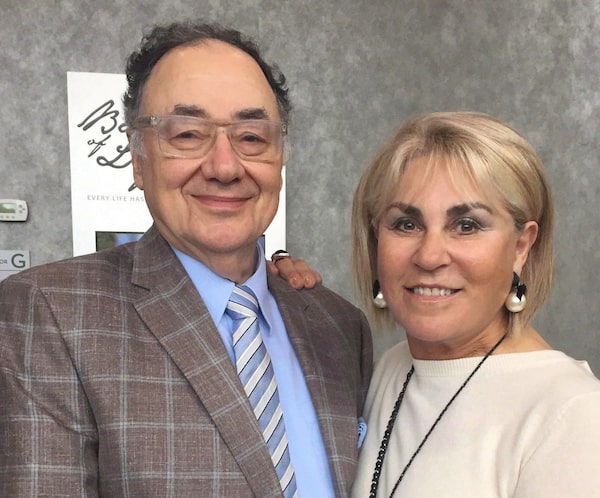
Barry and Honey Sherman are shown in a handout photo from the United Jewish Appeal.HO/The Canadian Press/United Jewish Appeal
- Title: The Billionaire Murders: The Mysterious Deaths of Barry and Honey Sherman
- Author: Kevin Donovan
- Genre: Non-fiction
- Publisher: Viking
- Pages: 328
Almost by accident, while covering Toronto City Hall for The Globe and Mail, I ended up being the first reporter to break the news that generic-drug billionaire Barry Sherman and his wife, Honey, had been found dead in their basement.
Early one Friday afternoon in December, 2017, I got a call from a former city councillor close to the family. At first, I thought there must be some mistake. But a police source confirmed that officers were indeed at the couple’s North York home, where it would later emerge the pair had been tethered by their necks to the railing of their indoor pool.
I was soon getting calls from CNN and the BBC. Within days, I was covering the couple’s massive funeral, where grieving son Jonathon swore in his eulogy and lashed out at the media coverage of his parents’ deaths. One of four Sherman children presumably in line to inherit a share of the couple’s more-than-$4.7-billion fortune, he was reacting to the reporting that weekend that police sources believed the case a likely murder-suicide. It was a cloud that hung unspoken over their funeral, which was stacked with dignitaries. It also turned out to be completely wrong.
I soon returned to my daily duties at city hall, while the puzzling killings turned every Toronto Christmas party that year into an unseemly meeting of armchair detectives. But Kevin Donovan, the Toronto Star’s award-winning chief investigative reporter, was just getting started. As he relates in his new book, The Billionaire Murders: The Mysterious Deaths of Barry and Honey Sherman, Donovan set out determined to dig up what happened, even as police and the family remained silent.
Along the way, he meets with a confidential source he codenames “Zero,” and even acts as the Star’s lawyer – with no legal training – going to court himself to question police in a bid to unseal search-warrant documents.
The result is a compelling narrative that reveals everything one of the country’s best dog-with-a-bone reporters was able to discover about the case, even though, in the end, the killings themselves remain a mystery.
Early distrust of the police saw the family hire a team of ex-cop private investigators headed by prominent criminal lawyer Brian Greenspan to do a parallel probe, starting with a second round of autopsies. It was this team’s conclusion that the pair were murdered – which Donovan reported on the front page of the Star – that finally prompts the police to reclassify the case as a double homicide. It’s one of many apparent police failings Donovan documents: Investigators also waited either days or weeks to review key surveillance video and interview key witnesses or even potential suspects.
He blames the missteps on the fact that at the time, the city’s top homicide detectives were also on the trail of serial killer Bruce McArthur, arrested a month after the Shermans were killed.
At times, the ocean of details Donovan has gathered threatens to drown readers with tangential information, such as accounts of phone calls to a retired coroner or the architecture of the building in which autopsies are performed. But these are minor distractions.
As best he can, he provides glimpses of the family tensions that boiled over after the murders. Donovan smartly splices the narrative of the murders and their aftermath – where concrete facts remain sparse – with chapters on Barry and Honey’s lives and the rise of Mr. Sherman’s company, Apotex. These details paint a textured but sympathetic portrait of the workaholic, litigious Barry – a billionaire whose preferred breakfast included Frosted Flakes – and his friendly but strong-willed wife.
While the police remain silent about what progress, if any, they have made, Donovan takes us to the people churned up by the rumour mill that came after the deaths. Barry threw millions at business ventures launched by his unlikely friend, B-movie filmmaker and beer-and-beverage pitchman Frank D’Angelo – a relationship that was the subject of e-mail disagreements Donovan uncovered between Barry and son Jonathon. D’Angelo tells Donovan the billionaire was “like a brother to me.”
Donovan also interviews an agitated Kerry Winter, one of Barry’s orphaned cousins who engaged in a long legal battle alleging he was owed a share of the Apotex fortune – arguments tossed by a judge just before the killings. Winter made a series of strange comments after the deaths, denying he had killed the couple, but volunteering that he he had fantasized about murdering Barry and alleging Barry had once asked him about hiring a hitman to kill Honey.
And in the book’s last few pages, Donovan turns to the camera and gives us his own cautious take on who the murderers might be, dismissing notions it was a contract hit from an enemy in Big Pharma, or a burned business associate or a fraudster. The attempt to make the scene look like a murder-suicide was too amateurish for professional hitmen, he says, even though it appeared to confuse Toronto police for weeks. The time and place of the killings suggest a killer or killers who knew the couple’s schedule intimately, Donovan says, and knew the home had no working security cameras.
But despite all of Donovan’s exhaustive reporting, there is no big reveal in this book, although not for lack of effort. It’s a true-crime murder mystery that – unlike its fictional relatives – has no tidy ending, with no killer unmasked.
Jeff Gray covers Queen’s Park for The Globe and Mail.
Expand your mind and build your reading list with the Books newsletter. Sign up today.
 Jeff Gray
Jeff Gray